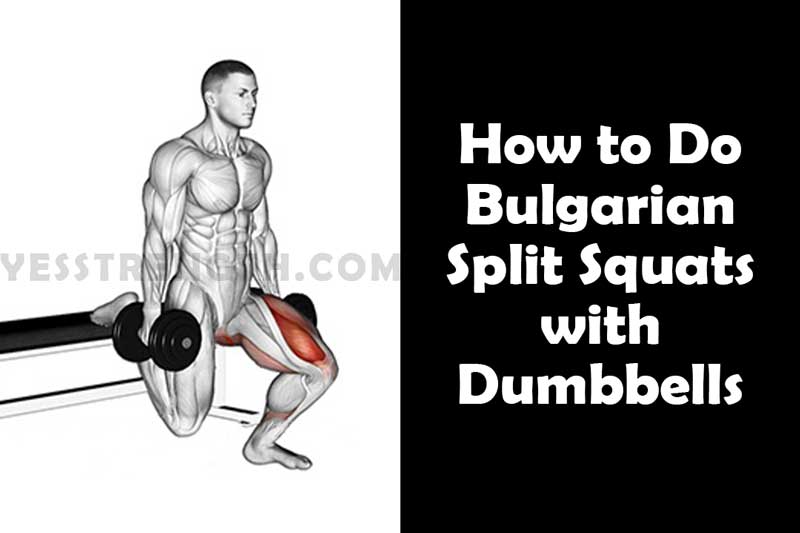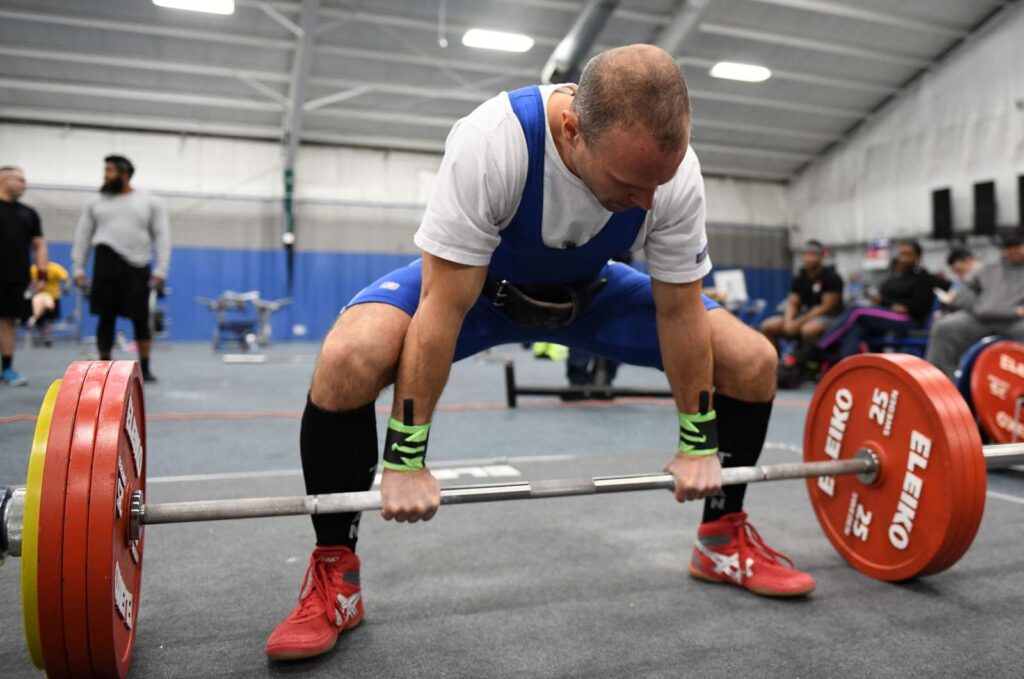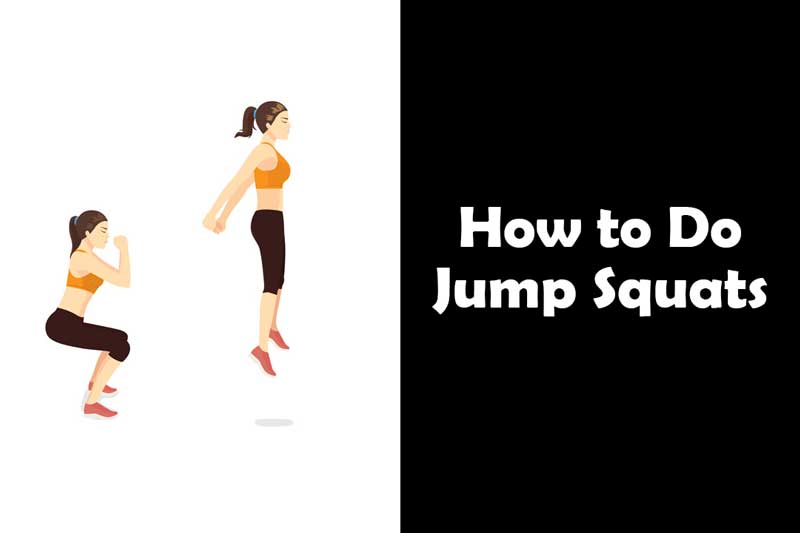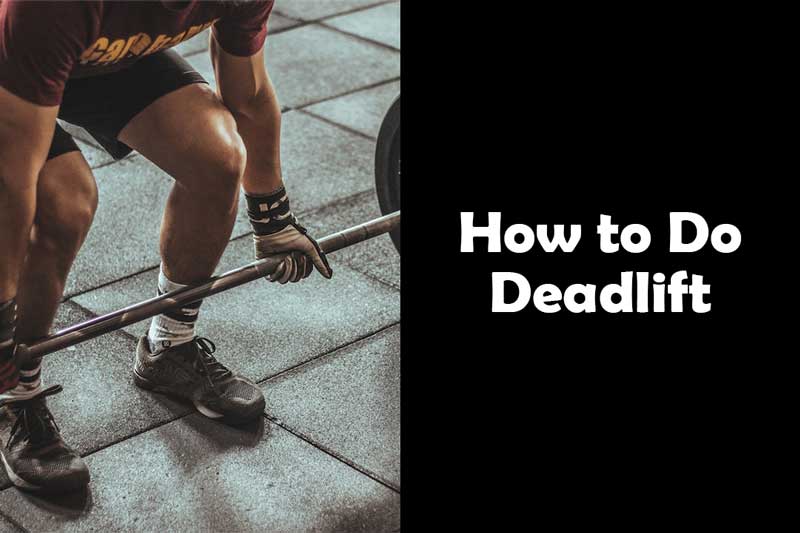Hey, fitness enthusiasts! Are you ready to kick your leg workout up a notch? Prepare to dive headfirst into the world of Bulgarian split squats with dumbbells, where strength meets intensity and gains are waiting to be conquered!
Say goodbye to mundane leg exercises that leave you feeling uninspired. It’s time to embrace the burn, challenge your muscles, and unveil the true power of your lower body.
So, buckle up, grab your trusty dumbbells, and get ready to ignite your leg muscles like never before.
In this article, we’ll provide you with a step-by-step guide on how to perform Bulgarian split squats with dumbbells correctly. Whether you’re a beginner or an experienced lifter, you’ll find valuable tips and techniques to enhance your training routine. Get ready to unleash your leg beast mode and make those gains roar with Bulgarian split squats! Let’s do this!
What are Bulgarian Split Squats?
Bulgarian split squats, also known as rear foot elevated split squats, are a unilateral exercise that helps improve balance, stability, and coordination.
By using dumbbells in this exercise, you add an additional challenge, making it more effective for building muscle and strength.
Benefits of Bulgarian Split Squats
- Strengthening the lower body: Bulgarian split squats primarily target the quads, hamstrings, and glutes, helping you develop strong and well-defined leg muscles.
- Improved balance and stability: Performing the exercise unilaterally forces your body to engage its stabilizer muscles, improving your overall balance and stability.
- Core engagement: The exercise requires you to engage your core to maintain an upright position, thereby strengthening your abdominal muscles.
- Increased range of motion: Bulgarian split squats allow for a greater range of motion compared to traditional squats, which can lead to improved flexibility.
- Sports performance enhancement: This exercise mimics movements used in various sports, such as running, jumping, and cutting motions, making it beneficial for athletes.
Muscles Worked Bulgarian Split Squats with Dumbbells
When it comes to Bulgarian split squats with dumbbells, it’s not just about looking good in your favorite pair of jeans or shorts. This powerhouse exercise targets multiple muscles in your lower body, helping you build strength, stability, and a well-rounded physique. Let’s take a closer look at the muscles that get fired up during this challenging movement:
1. Quadriceps
Your quads, the muscles located at the front of your thighs, are heavily engaged in Bulgarian split squats. As you descend into the squat position, your quads work hard to control the movement and push you back up to the starting position.
Strong quads not only contribute to overall leg strength but also play a crucial role in various athletic activities.
2. Hamstrings
Located at the back of your thighs, the hamstrings also play a significant role in Bulgarian split squats.
These muscles help stabilize your knee joint and work in tandem with your quads to control your descent and ascent during the exercise.
Strengthening your hamstrings is crucial for achieving balanced lower body development and also reducing the risk of hamstring-related injuries.
3. Glutes
Prepare for some serious booty gains! Bulgarian split squats target your glute muscles, including the gluteus maximus (the largest muscle in your gluteal region) and the gluteus medius.
These muscles are responsible for hip extension, which is essential for movements like running, jumping, and squatting.
By incorporating Bulgarian split squats into your routine, you’ll further enhance the shape and strength of your glutes.
4. Calves
Your calves are not left out in the Bulgarian split squat. So, as you push through your front heel to rise back up, your calf muscles contract, providing stability and assisting in the upward movement.
Strong calves contribute to better ankle stability and overall lower body strength.
5. Core Muscles
Don’t underestimate the role of your core in Bulgarian split squats! Your core muscles, including your abdominals and obliques, engage to stabilize your torso and maintain an upright position throughout the exercise.
A strong core not only enhances your performance but also helps prevent lower back pain and improves overall posture.
6. Stabilizer Muscles
Bulgarian split squats challenge your stabilizer muscles, which are responsible for maintaining balance and controlling movement.
These include the muscles in your hips, lower back, and even your feet and ankles. By performing this exercise, you’ll enhance the overall stability and coordination of your lower body.

Getting Ready: Equipment and Setup
Before you begin, make sure you have the following equipment:
- A pair of dumbbells: Choose weights that are suitable for your fitness level. Start with lighter dumbbells if you’re a beginner and gradually increase the weight as you get stronger.
- A sturdy bench or platform: You’ll need a stable surface to elevate your rear foot during the exercise.
Set up the bench or platform in front of you, and place one foot behind you, resting the top of your foot on the bench.
Proper Form and Technique
Maintaining proper form is crucial for getting the most out of Bulgarian split squats. Here are some key points to remember:
- Keep your upper body upright: Maintain an upright posture throughout the exercise, with your chest lifted and shoulders back.
- Engage your core: Activate your core muscles by pulling your belly button in towards your spine. This will help stabilize your torso.
- Step forward: Take a big step forward with your front foot, ensuring your knee is directly above your ankle when in the lowered position.
- Lower yourself: Bend your front knee and lower your body towards the ground, keeping your back straight and your weight centered on your front heel.
- Maintain control: Lower yourself down slowly and under control, avoiding any sudden movements or jerking motions.
- Push through your front heel: As you rise back up, focus on driving through your front heel to engage your glutes and hamstrings.
- Avoid excessive forward lean: Try to keep your torso upright and avoid leaning too far forward, as this can put unnecessary strain on your lower back.
Step-by-Step Guide to Bulgarian Split Squats with Dumbbells
Now let’s dive into the step-by-step process of performing Bulgarian split squats with dumbbells:
1) Starting Position
- Stand with your feet hip-width apart and hold a dumbbell in each hand.
- Then, take a big step forward with your right foot and place the top of your left foot on the bench behind you.
- Position your right foot far enough forward so that when you lower your body, your right knee is directly above your ankle.
2) Lowering Phase
- Inhale and then start descending by bending your right knee, lowering your body towards the ground.
- Maintain an upright posture, keeping your chest lifted and shoulders back.
- Go as low as you can while maintaining balance and proper form. Aim for your right thigh to be parallel to the ground.
3) Bottom Position
- Pause briefly at the bottom of the movement, ensuring stability and control.
- Keep your core engaged and avoid any bouncing or sudden movements.
4) Rising Phase
- Exhale and then push through your right heel to rise back up to the starting position.
- Focus on using your right quad, glute, and hamstring muscles to lift your body.
- Keep your upper body stable and avoid any excessive leaning forward.
5) Repeat on the Other Leg
- After completing the desired number of repetitions on your right leg, switch sides.
- Take a big step forward with your left foot and place the top of your right foot on the bench.
- Repeat the entire movement, following the same technique and form as before.
Common Mistakes to Avoid
To ensure you get the most out of Bulgarian split squats, watch out for these common mistakes:
- Allowing the front knee to go past the toes: This can put excessive strain on the knee joint. So, keep your knee aligned with your ankle throughout the movement.
- Leaning too far forward: Maintain an upright posture to engage the targeted muscles effectively and prevent undue stress on your lower back.
- Lack of control and balance: Focus on performing the exercise in a controlled manner, avoiding any jerking or unsteady movements.
- Neglecting core engagement: Remember to activate your core muscles to stabilize your body and maintain proper form.
Variations and Progressions
Once you’ve mastered the basic Bulgarian split squat with dumbbells, you can consider trying these variations and progressions to challenge your muscles further:
- Rear foot elevated split squats without dumbbells: Begin by mastering the bodyweight version before adding external resistance.
- Front foot elevated split squats: Elevate the front foot instead of the rear foot to shift the focus to the front leg.
- Bulgarian split squats with barbells: Replace the dumbbells with a barbell across your upper back for increased resistance.
Incorporating Bulgarian Split Squats into Your Workout Routine
To incorporate Bulgarian split squats effectively into your workout routine, consider the following tips:
- Frequency: Perform Bulgarian split squats 2-3 times per week, allowing your muscles to recover between sessions.
- Sets and repetitions: Start with 2-3 sets of 8-12 repetitions per leg, gradually increasing the intensity as you progress.
- Rest periods: Take 1-2 minutes of rest between sets to allow your muscles to recover.
- Superset with other exercises: Pair Bulgarian split squats with exercises that target different muscle groups, such as upper body exercises or core exercises, for a well-rounded workout.
- Progressive overload: Continually challenge yourself by increasing the weight, reps, or sets over time to promote muscle growth and strength gains.
Safety Precautions
While Bulgarian split squats with dumbbells are generally safe, it’s essential to prioritize safety during your workouts. Consider the following precautions:
- Warm-up: Begin each workout with a dynamic warm-up to increase blood flow to your muscles and prepare them for exercise.
- Start with lighter weights: If you’re new to Bulgarian split squats, begin with lighter dumbbells to practice proper form before gradually increasing the weight.
- Focus on stability: Maintain stability throughout the exercise to prevent any loss of balance or injury. If needed, perform the exercise near a wall or with a spotter for support.
- Listen to your body: If you experience pain or discomfort during the exercise, stop immediately and consult with a qualified fitness professional or healthcare provider.
- Progress gradually: Allow your body time to adapt to the exercise. Avoid progressing too quickly, as this can increase the risk of injury.
Conclusion
Bulgarian split squats with dumbbells are a challenging and effective exercise for strengthening your lower body. By following the proper form and technique outlined in this article, you can maximize the benefits of this exercise and achieve your fitness goals.
However, remember to start with lighter weights, focus on stability, and gradually progress over time. Because with consistency and dedication, you’ll experience improvements in strength, balance, and muscle definition.
Frequently Asked Questions (FAQs)
Q1: Can beginners perform Bulgarian split squats with dumbbells?
Absolutely! Beginners can start with lighter dumbbells or even bodyweight Bulgarian split squats. It’s important to focus on proper form and gradually increase the intensity as you gain strength and confidence.
Q2: Are Bulgarian split squats better than regular squats?
Both Bulgarian split squats and regular squats are valuable exercises. They target different muscle groups and have unique benefits. Including a variety of exercises in your routine can help you achieve a well-rounded lower body workout.
Q3: Can Bulgarian split squats help with improving my running performance?
Yes, Bulgarian split squats engage similar muscles used in running, such as the quadriceps, hamstrings, and glutes. By strengthening these muscles, you can improve your running performance and reduce the risk of injuries.
Q4: How do I choose the right weight for Bulgarian split squats with dumbbells?
Choose a weight that challenges you but allows you to maintain proper form throughout the exercise. Start with lighter dumbbells and gradually increase the weight as you become more comfortable and confident.
Q5: Can Bulgarian split squats help with knee pain?
Bulgarian split squats can help strengthen the muscles around the knees, potentially reducing knee pain. However, if you have existing knee issues or pain, it’s essential to consult with a healthcare professional before incorporating this exercise into your routine.





